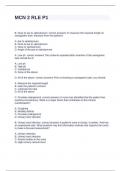MCN 2 RLE P1
B. Nose to ear to xiphisternum correct answers To measure the required length on
nasogastric tube, measure from the patient's:
A. Ear to xiphisternum
B. Nose to ear to xiphisternum
C. Nose to xiphisternum
D. Angle of the jaw to xiphisternum
A. Low ph correct answers The contents aspirated after insertion of the nasogastric
tube should be of:
A. Low ph
B. High ph
C. Variable ph
D. None of the above
D. All of the above correct answers Prior to inserting a nasogastric tube, you should:
A. Measure the required length
B. Gain the patient's consent
C. Lubricate the tube
D. All of the above
C. Prostate enlargement correct answers A nurse has identified that the patient has
overflow incontinence. What is a major factor that contributes to this clinical
manifestation?
A. Coughing
B. Mobility deficits
C. Prostate enlargement
D. Urinary tract infection
B. Urinary tract infection correct answers A patient's urine is cloudy. Is amber. And has
an unpleasant odor. What problem may this information indicate that requires the nurse
to make a focused assessment?
A. Urinary retention
B. Urinary tract infection
C. Ketone bodies in the urine
D. High urinary calcium level
,C. positioning a bedside commode near the bed correct answers A nurse is caring for a
debilitated female patient with nocturia. Which nursing intervention is the priority when
planning to meet this patient's needs?
A. encouraging the use of bladder training exercises
B. providing assistance with toileting every four hours
C. positioning a bedside commode near the bed
D. teaching the avoidance of fluids after 5pm
A. use a sterile specimen container correct answers A practitioner orders a urine
specimen for culture and sensitivity via a straight catheter for a patient. What should the
nurse do when collecting this urine specimen?
A. use a sterile specimen container
B. collect urine from the catheter port
C. inflate the balloon with 10ml of sterile water
D. have the patient void before collecting the specimen
A. Check to see whether the catheter is patent correct answers A client who has an
indwelling catheter reports I need to urinate. Which of the following interventions should
the nurse perform?
A. Check to see whether the catheter is patent
B. Reassure the client that it is not possible for her to urinate
C. Re-catheterize the bladder with a larger gauge catheter
D. Collect a urine specimen for analysis
B. Fibrous, glandular, and adipose tissues. correct answers Which of the following
statements is true regarding the internal structures of the breast? The breast is made up
of:
A. Primarily muscle with very little fibrous tissue.
B. Fibrous, glandular, and adipose tissues.
C. Primarily milk ducts, known as lactiferous ducts.
D. Glandular tissue, which supports the breast by attaching to the chest wall.
B. The location of most breast tumors. correct answers In performing a breast
examination, the nurse knows that examining the upper outer quadrant of the breast is
especially important. The reason for this is that the upper outer quadrant is:
A. The largest quadrant of the breast.
B. The location of most breast tumors.
C. Where most of the suspensory ligaments attach.
D. More prone to injury and calcifications than other locations in the breast.
, C. Central, lateral, pectoral, and subscapular correct answers In performing an
assessment of a woman's axillary lymph system, the nurse should assess which of
these nodes?
A. Central, axillary, lateral, and sternal
B. Pectoral, lateral, anterior, and sternal
C. Central, lateral, pectoral, and subscapular
D. Lateral, pectoral, axillary, and suprascapular
C. Ask the patient some additional questions about the medications she is taking.
correct answers During a health history interview, a female patient states that she has
noticed a few drops of clear discharge from her right nipple. What should the nurse do
next?
A. Immediately contact the physician to report the discharge.
B. Ask her if she is possibly pregnant.
C. Ask the patient some additional questions about the medications she is taking.
D. Immediately obtain a sample for culture and sensitivity testing.
C. "Where did the rash first appear—on the nipple, the areola, or the surrounding skin?"
correct answers During a physical examination, a 45-year-old woman states that she
has had a crusty, itchy rash on her breast for approximately 2 weeks. In trying to find
the cause of the rash, which question would be important for the nurse to ask?
A. "Is the rash raised and red?"
B. "Does it appear to be cyclic?"
C. "Where did the rash first appear—on the nipple, the areola, or the surrounding skin?"
D. "What was she doing when she first noticed the rash, and do her actions make it
worse?"
A. "The testicle should feel smooth, rounded, and firm."
C. "The best time to perform the exam is in the shower or bath."
D. "If your testicle has any lumps or is enlarged, call your healthcare provider."
E. "It is normal to feel the epididymis on top of and behind each testicle." correct
answers Which statements should the nurse include when providing client education
regarding testicular self-examination? Select all that apply.
A. "The testicle should feel smooth, rounded, and firm."
B. "Apply gentle pressure with your thumb, index, and middle fingers. Your testicle
should hurt when you feel it."
C. "The best time to perform the exam is in the shower or bath."
D. "If your testicle has any lumps or is enlarged, call your healthcare provider."
E. "It is normal to feel the epididymis on top of and behind each testicle."




